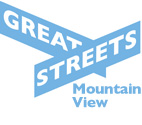by jarkatmu | Jul 3, 2013 | California Street, City Council, Council Meeting, Escuela Avenue
On Tuesday, June 18, City Council formally approved the 2013-2014 Capital Improvement Program (CIP) list including $250,000 for the California Street and Escuela Avenue study!
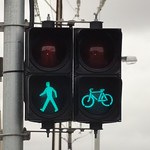
Green light for bicycle and pedestrian friendly streets! Image: Flickr user The Scooter Guy.
The CIP is funded as a part of the FY 2013-14 budget and the decision on May 21 maintained the proposed bicycle and pedestrian CIP projects.
With the hard work of the Great Streets Rengstoff Park neighborhood coalition, including letters and emails sent to council, and seventeen people attending the CIP study Session May 21st, we have taken one step closer to neighborhood streets that are great places and safe for everyone.
We want to especially thank city council and city staff for their work to bring these ideas to the table. By prioritizing investment in safer, more beautiful streets, we all benefit from an asset that touches every person who lives, works, or travels in our city.
We are researching next steps for the California Street and Escuela Avenue study with city staff. We do know there will be many opportunities for public input, so start thinking about what you, your family, and neighbors might like to see on a livable California Street.
The asphalt canvas is yours. What would you like to see? More street trees? wider sidewalks? protected bike lanes? Let us know in the comments and for the latest information don’t forget to sign up for our newsletter.
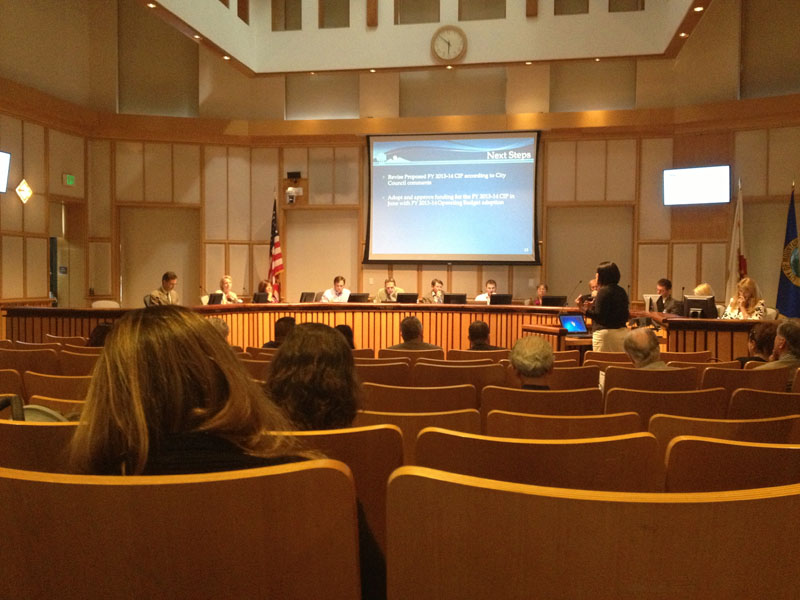
by jarkatmu | May 30, 2013 | California Street, Council Meeting, Escuela Avenue, Esculea Avenue
Good news! At the May 21 City Council Meeting, nearly twenty people spoke in support of the many bicycle and pedestrian safety and livability projects proposed for the city’s Capital Improvement Program. Council elected to move all projects forward as proposed, including the California Street and Escuela Avenue study.
If you were able to attend the meeting or write a letter to council prior to the meeting, thank you! It’s important that our elected officials hear the policies changes that people want to see in their neighborhood. Without your support, the progress we’ve achieved thus far would not have been possible. Thank you.
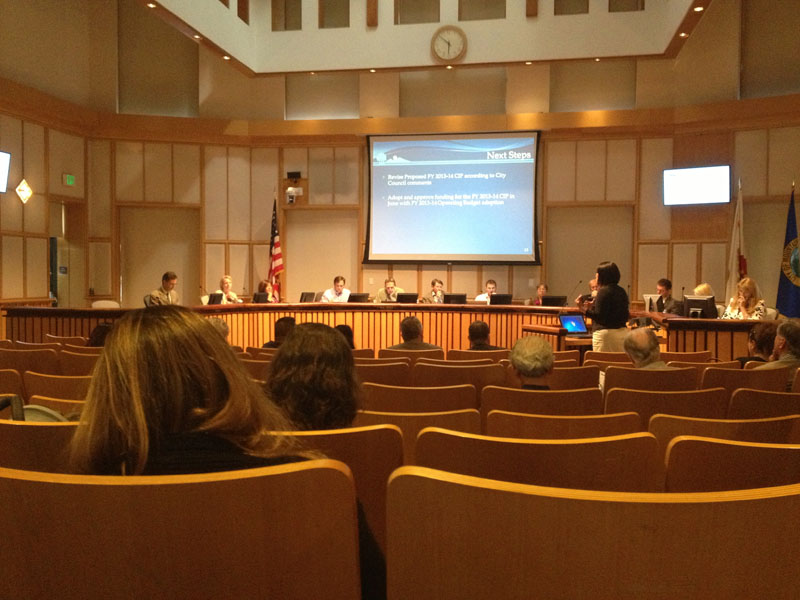
If you were you here last week or you wrote a letter, thank you!
Council will make the final funding decision on the Capital Improvement Program on June 18th as part of a larger budget package. Due in large part to the feedback at last week’s meeting, we believe the projects will move forward as proposed. If you missed the meeting or weren’t able to send an e-mail, there is still time! Let council know that you support safe, beautiful, and livable streets here.
Once Council votes “yes” on the funding package on June 18, Expect a several month gap between funding and the study kick-off, but once a city planning consultant is selected, prepare for a series of interactive workshops. You can build the type of street you want to see with technical assistance from designers and planners– know of a place where you always wanted a tree or a crosswalk safe enough for your family? This is the place to do it! Unlike the council meetings, these events are informal and can even be really fun! Unleash your creativity.
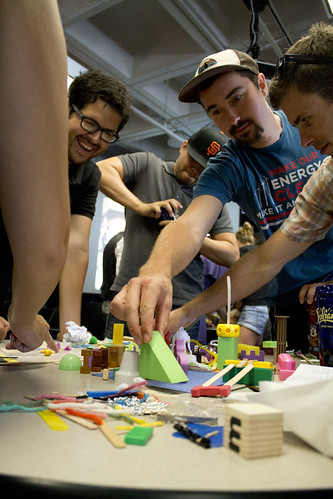
Ideally, workshops are interactive and organized ways to provide input. We may even see Legos, like at this planning workshop in San Luis Obispo! Source: Robert E. Kennedy Library
When the study concludes, the planners will create and present alternatives. Council will ultimately pick an alternative, but your voices can dramatically affect which option is chosen. Obtaining funding and constructing the project is the final step, but California and Escuela are well positioned to receive funding since both streets connect schools, housing, and services.
The entire California/Escuela study process may take two years. Two years may seem like a long time, but keep in mind many roads remain unchanged for decades, just like California Street and Escuela Avenue which were built in the 1950’s. In the context of the city and change, two years is a short wait for great, safe streets that will endure for future generations.
While the combined study and construction are several years out at best we will be watching and will continue to need your support to ensure that our call for safer more beautiful streets for all residents of Mountain View, from the eight year old on her way to school to her 80 year old grandmother, is heard.
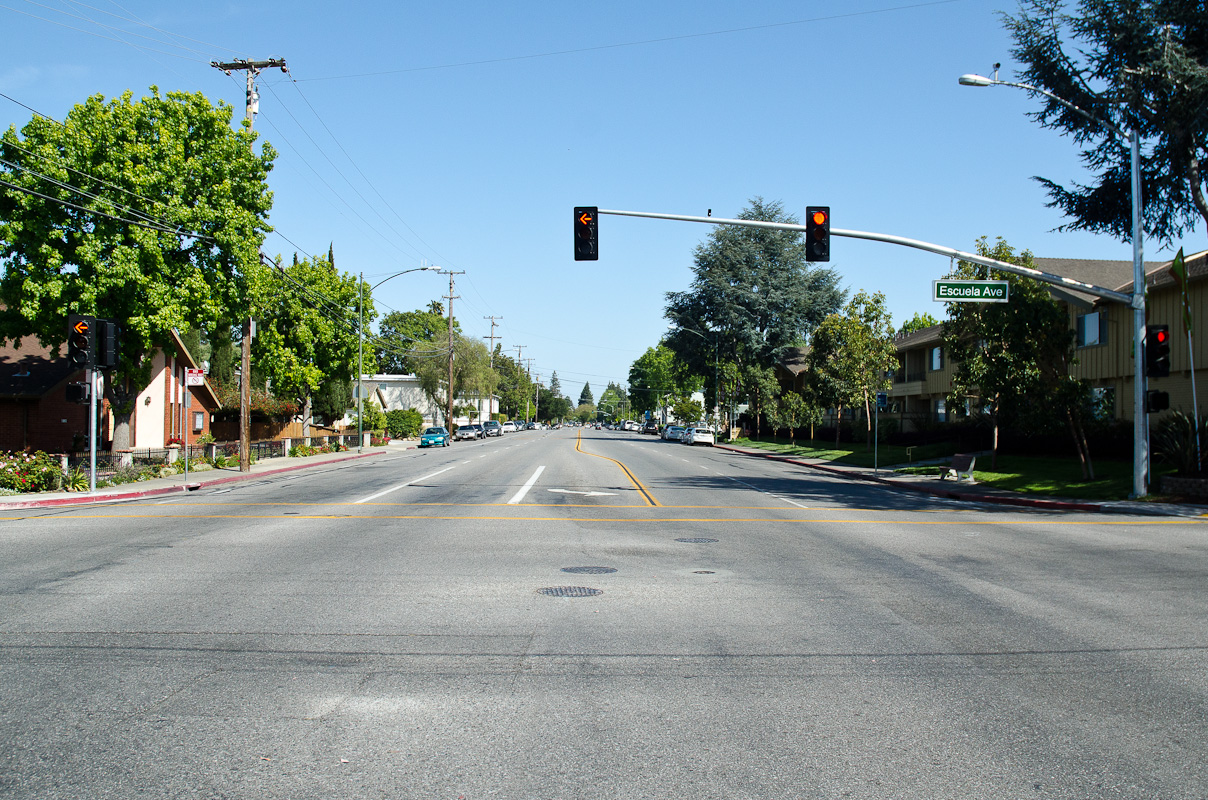
by jarkatmu | May 20, 2013 | California Street, City Council, Council Meeting, Escuela Avenue, Events
On Tuesday, May 21 at 5PM, Mountain View City Council will discuss the future of street safety in Mountain View. If you’ve ever travelled down a street in the Rengstorff Park area of Mountain View and thought that it could be more beautiful, livable, and safer, Tuesday evening is your opportunity to take action and make a difference!
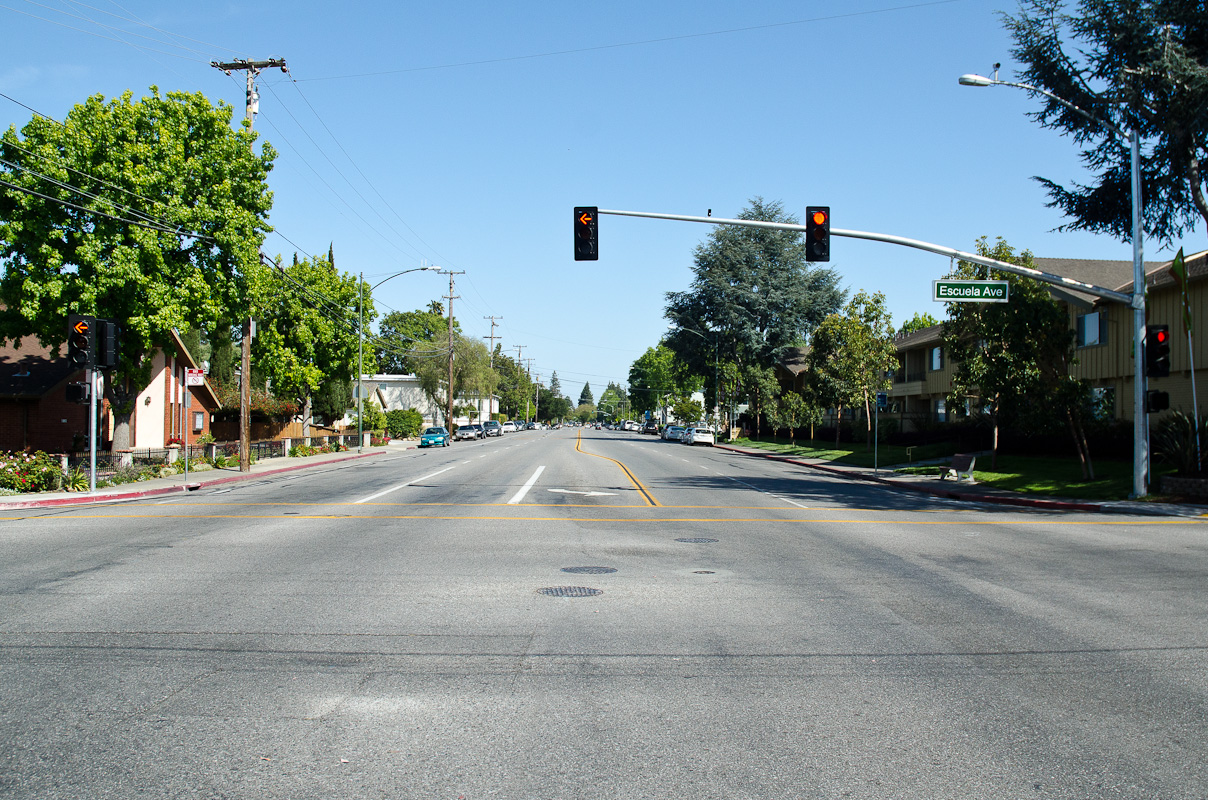
Opportunity beckons .
Come to City Hall at 500 Castro Street at 5PM. The meeting will be in the council chambers which are on the second floor of City Hall- it’s well marked, you can’t miss it. Council will be discussing the Capital Improvement Program and a number of projects are included in the staff report that will improve bicycle and pedestrian safety, including the California Street and Escuela Avenue study which will analyze beautification and safety improvement measures on both streets.
After discussion, the floor is open for public comment! Now’s the time to speak for safer streets. Please tell council that you support the street safety and beautification projects in the Capital Improvement Program and particularly support the California Street and Escuela Avenue Study with the road diet alternative.
We believe the road diet alternative is one of the best potential interventions for reducing crashes and making the street more livable while not seriously impacting drivers. If you would like more information on the road diet, please read our earlier post here.
Hope to see you there! Bring a friend! Once again, the date is this Tuesday, May 21 at 5PM at City Hall, 500 Castro Street. The Capital Improvement Program is the first item on the agenda, so discussion shouldn’t go past 6:30PM. If you can’t make it, please send the Council an e-mail expressing support.
by jarkatmu | May 5, 2013 | California Street, City Council, Council Meeting, Escuela Avenue, Events
The time has come! On Tuesday, May 21 at City Hall, Council will be voting on funding for improving safety on two streets in the Rengstorff Park area and we need you to be there!
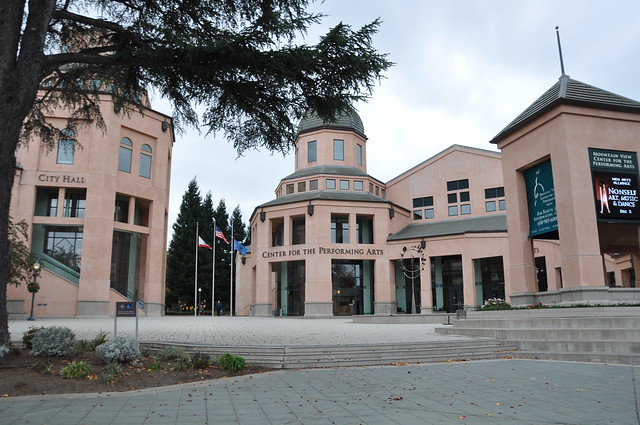
Like safer streets? This is the place to be on the evening of Tuesday May 21!
That evening, City Council will be voting on a number of projects as part of the Capital Improvement Program List. This list is only chosen every two years and typically includes projects that are over $50,000 and are upgrades of city infrastructure. Included are a handful of projects that will elevate street safety in the Rengstorff Park neighborhood and other parts of the city. Together with projects such as the Castro Street road diet, Council will be considering a project labeled as the California Street/Escuela Avenue Improvement Study.
This study is the first step towards a safer, more beautiful California Street and Escuela Avenue– and the first step towards great streets in the Rengstorff Park neighborhood! Here’s the project description– it reflects a lot of the ideas put forth by Great Streets Rengstorff Park.
California Street/Escuela Avenue Improvement Study: This project would study options to improve the bicycling and pedestrian environment along and across California Street. Improvements would be explored with and without reducing a travel lane in each direction. Examples of possible improvements include elimination or narrowing of vehicle lanes, increased area for bicyclists, curb bulbs to reduce crossing width for pedestrians, and improved lighting and signage. An analysis of the traffic impacts associated with lane reduction (road diet) will be included. The study would also consider pedestrian and bicycle activity to facilities on Escuela Avenue (e.g., Castro Elementary School, Senior Center, Teen Center).
City Council have made street safety efforts a high priority as part of their 2013 goal-setting initiative but, we must demonstrate that there’s strong support from those who live near and use these streets everyday.
Please join us on May 21 and voice support for the California Street/Escuela Avenue Improvement Study. Specifically, show support for analyzing the California Street road diet as part of the study. We’re confident that it can work, and would welcome the more detailed analysis that comes with the traffic study, but Council could choose to eliminate it from the study during the May 21 meeting.
The road diet has the strongest potential to reduce crashes and make the street a more inviting place, and we hope that you will join us in voicing support for the study and the road diet.
The date and time once again– Tuesday, May 21; Approximately 5:30PM; 500 Castro Street, Downtown Mountain View
[googlemaps https://maps.google.com/maps?f=q&source=s_q&hl=en&geocode=&q=500+Castro+Street,+Mountain+View,+CA&aq=0&oq=500+castro&sll=37.269174,-119.306607&sspn=12.246869,23.994141&t=h&ie=UTF8&hq=&hnear=500+Castro+St,+Mountain+View,+Santa+Clara,+California+94041&ll=37.389773,-122.082934&spn=0.011951,0.023432&z=14&output=embed&w=425&h=350]
If you can’t make the meeting, please send council an e-mail expressing support for the California Street/Escuela Avenue study, including the California Street road diet alternative.
As always, sign up for our Newsletter for the latest information.
by jarkatmu | Mar 16, 2013 | California Street, City Council, Events, Press
We hope you joined us on March 2nd for GSRP’s first ever bike tour of our area! More than 40 community members attended including councilmembers Ronit Bryant and Margaret Abe-Koga, Environmental Planning Commissioner Margaret Capriles, and Community Development Director Randy Tsuda. I could tell you all about it but we received three write-ups in local papers. Check out the articles and take a gander at the tour brochure to get a sense of the ride if you could not join us. If you did join us, you might want to read articles from the Mountain View Voice and the San Jose Mercury News to see if you are in the pictures or mentioned in the articles.
Special thanks to the speakers who shared their experiences on the tour: Valeria Craven, Howie and Dana Meyerson, John and Karen Farrell from Bumble Bee Health Foods, Elena Pacheco, Ariel T. Mendez, Thida Cornes, and Jack Miller. We would also like to thank Google for providing loaner bikes and the Silicon Valley Bicycle Coalition for providing liability insurance. Safe Moves was also in attendance to share information on the city’s bike education program at schools!
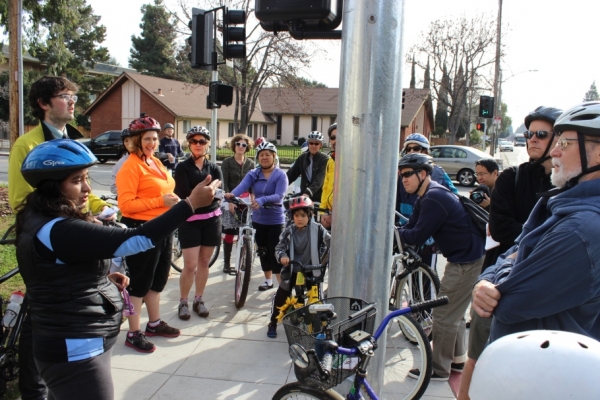
Tour attendes listen to Valeria Craven, left, as she describes the danger crossing the Escuela and California Intersection. Photo By Daniel DeBolt, Mountain View Voice.
At meetings on the Tuesday and Wednesday following the tour, Councilmembers and the Bicycle and Pedestrian Advisory Committee discussed funding for bicycle and pedestrian safety projects in the context of the crucial Capital Improvement Program (CIP) list.
CIP projects are items that City Council deems important to the City of Mountain View and are prioritized annually. The projects cost over $50,000 and cover needs such as improved Fire Department Communication systems and upgraded methane release valves in North Bayshore to street safety projects such as the potential road diet for California Street and bike lanes on Escuela Avenue.
During the Council meetings, elected officials and members of the public spoke strongly in support of projects that improve safety and livability, some even cited the bike tour and newspaper articles. Ultimately, California Street and Escuela Avenue made it into the CIP list! The city will examine a range of alternatives to improve the safety and aesthetics of both streets and the Great Streets Rengstorff Park road diet proposal for California Street will likely be in the mix.
Councilmembers also spoke strongly in favor of allocating funding for immediate short-term improvements such as new striping and improved lighting.
The CIP list must still go through a final round of Council review in May, but we’re over the first hurdle and are ecstatic with Council’s enthusiasm for crafting safer, more livable streets in the Rengstoff Park area along with other parts of the city.
We will need your help leading up to the critical City Council funding meeting in May (Date TBD). If you are interesting in meeting individually with councilmembers, please contact us. However, attending the meeting is the most effective way of voicing support for safer, livable streets in the Rengstorff area. We know it can be difficult to find time for a Council meeting, but they are usually scheduled in the evening around 6PM on a Tuesday. If you attend just one council meeting, this is the one to attend.
The city hasn’t nailed down the meeting date yet but we will let you know through our newsletter as soon as we know. Please sign up for our newsletter if you haven’t already and we hope to see you in May!
by jarkatmu | Dec 11, 2012 | California Street, City Council
On November 20, Mountain View City Council held a study session on traffic safety, and Mayor Kasperzak and councilmembers Ronit Bryant and Laura Macias spoke strongly in support of taking action in the form of road design changes to improve safety and make it easier and safer to get around when walking or biking. The study session was held in response to the recent rash of collisions between cars and students walking and biking to local schools, the April case of reckless driving that killed William Ware as he waited for a bus, and growing public awareness that the status quo is negatively impacting the quality of life in the city.
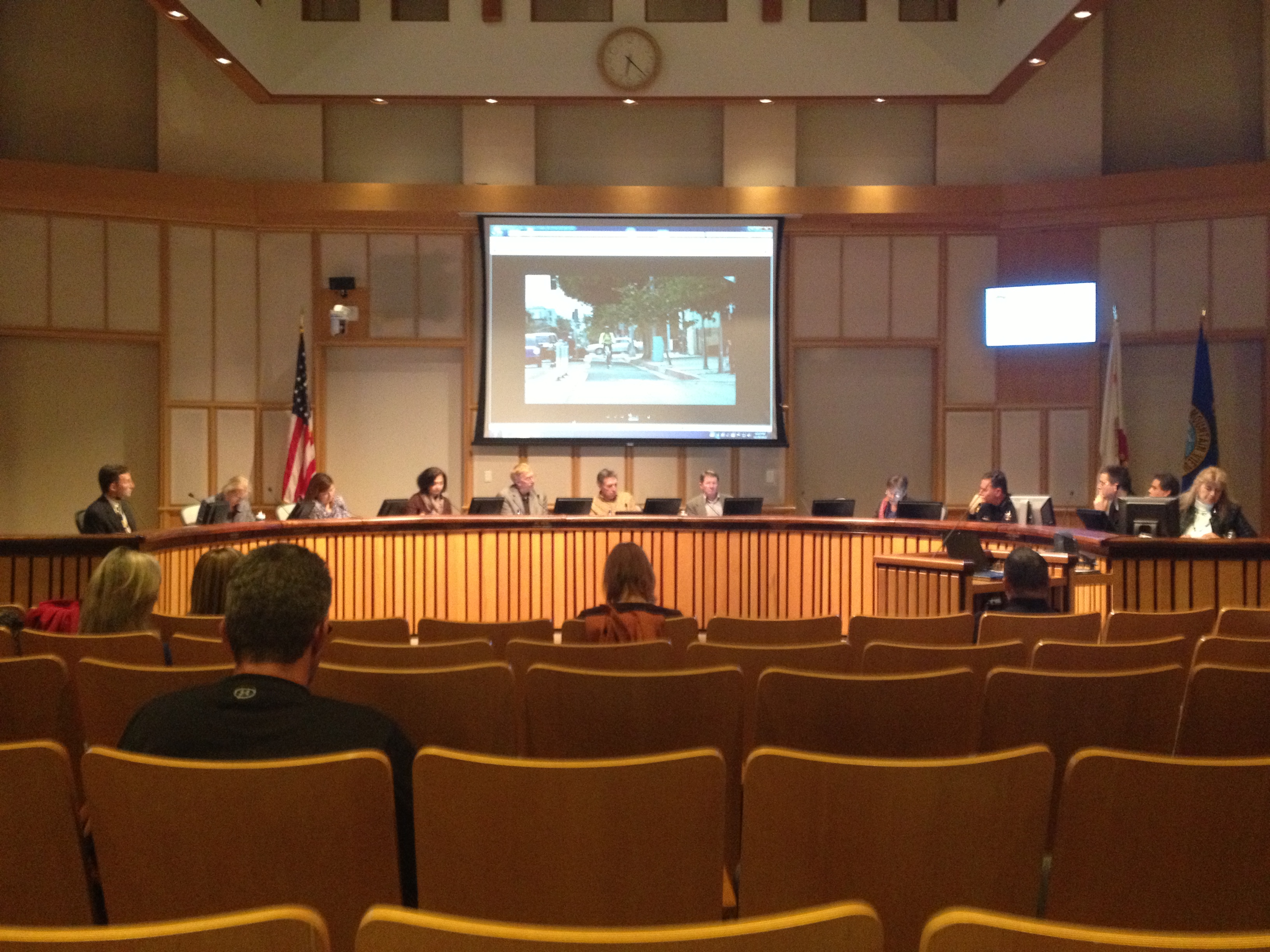
Councilmember Laura Macias briefs the council on safe bicycle street design at the November 20 study session.
City Staff and the Police Department gave a presentation outlining the the student education, enforcement, and data collection efforts that are currently ongoing. Public Works Director Michael Fuller discussed some of the solutions that they are working on including tree trimming, lighting, and potential speed limit reduction, particularly around schools.
In the short-term, ticketing, student education, and tree trimming are strong steps forward for safer and more livable streets, but in the long term, road design changes are necessary. Reducing speed limits on roads like California Street may have some impact on behavior, but as Traffic Officer Lopez from the MVPD commented at a The Shoreline West Association of Neighbors traffic safety meeting: “Once we’re gone, people speed up again.”
The reason people speed once the police leave is because the design of the road sends information to drivers. The ability to see far down the road, wide lanes, and broad corners all contribute to a perception that speeding is normal and accepted. California Street is a prime example of this condition. The long blocks, wide lanes, and rounded corners allow drivers to comfortably maintain high speeds despite traumatizing the people on foot and bike who use the street.
But isn’t speed okay? Speed can have its place on freeways and expressways, where the sole pupose of the road is to move cars quickly. However, on neighborhood streets there are numerous residents living in close proximity to the road and many bicyclists and pedestrians. Reducing speed is not only critical to creating a more livable environment, but should there be a collision between a driver and a pedestrian or bicyclist, small differences in speed are often the difference between life and death. According to numerous sources, 85% of pedestrians die when hit by a car travelling at 40MPH, 40% die at 30MPH, and 10% die at 20mph. The posted speed limit of most large streets in Mountain View is 35, and we know drivers often go faster. Recognizing the reality of our major streets, councilmember Ronit Bryant declared: “If it feels comfortable to be driving 40mph on our major streets, something needs to change.”

Relationship between speed and pedestrian fatalities.
Moving forward, Councilmember Laura Macias called for continued action at the city’s Transportation and Bicycle and Pedestrian Advisory Committee and Mayor Mike Kasperzak stated “I would like to see Mountain View out in front on these issues.” City Council will have an opportunity in January or February of 2013 to confirm their support of safer, more livable streets when they make recommendations for the Capital Improvement Project list. The California Street road diet and streetscape improvement project proposed by Great Streets Rengstorff Park could be added to this list, but your support of this and smilar projects are needed to make truly great streets. Once we have more information on key opportunities for public input, we hope you will join us in writing letters and attending meetings in support of better road design.
by jarkatmu | Sep 5, 2012 | California Street, Press
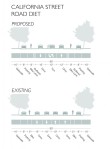
Before and After Street Section for California Street
As mentioned in the last post, the Great Streets Rengstorff Park project is was highlighted in the Mountain View Voice, with a focus on the safety improvements that are urgently needed for California Street following the tragic case of reckless driving that killed William Ware.
Judging from the comments, there was a lot of interest in the idea, but there were questions about California Street’s ability to function with two car lanes and one turn lane, instead of four car lanes. I thought it would be appropriate to go into a bit more detail about how the road diet can successfully work and why it’s good for California Street.
Capacity Isn’t Reduced
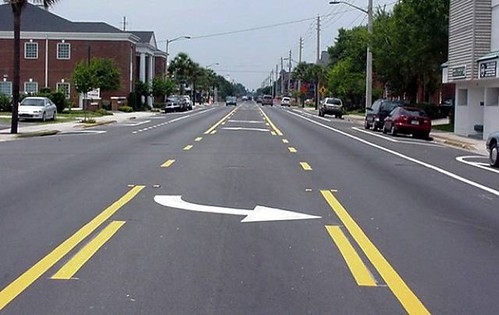
The new center turn lane is what makes road diets work for drivers and improves capacity.
According to research on lane reductions from around the country, streets that cary less than 20,000 cars per day are good candidates for road diets. These streets don’t cause spillover onto nearby streets because the new center turn lane improves capacity. The most recent City of Mountain View traffic data states California Street caries approximately 11,400 vehicles per day, well within the paramaters of a road diet.
While spillover vehicle traffic is an important factor, it should not be the only criteria for considering a road diet. Road diets substantially improve safety, make streets more livable, and provide extra space for safer movement of cyclists and pedestrians.
It’s Not Just About Cars
According to a study from the Federal Highway Administration (FHWA), road diets are proven solutions for safer streets, because they reduce vehicle speed and minimize conflicts that arise from multiple lanes, numerous driveways, and many pedestrian and bicycle crossing areas. The FHWA studied roads similar to California Street that went on a “diet,” and there was a 19 percent decrease in total crashes, described as “a substantial difference,” after controlling for changes in traffic counts.
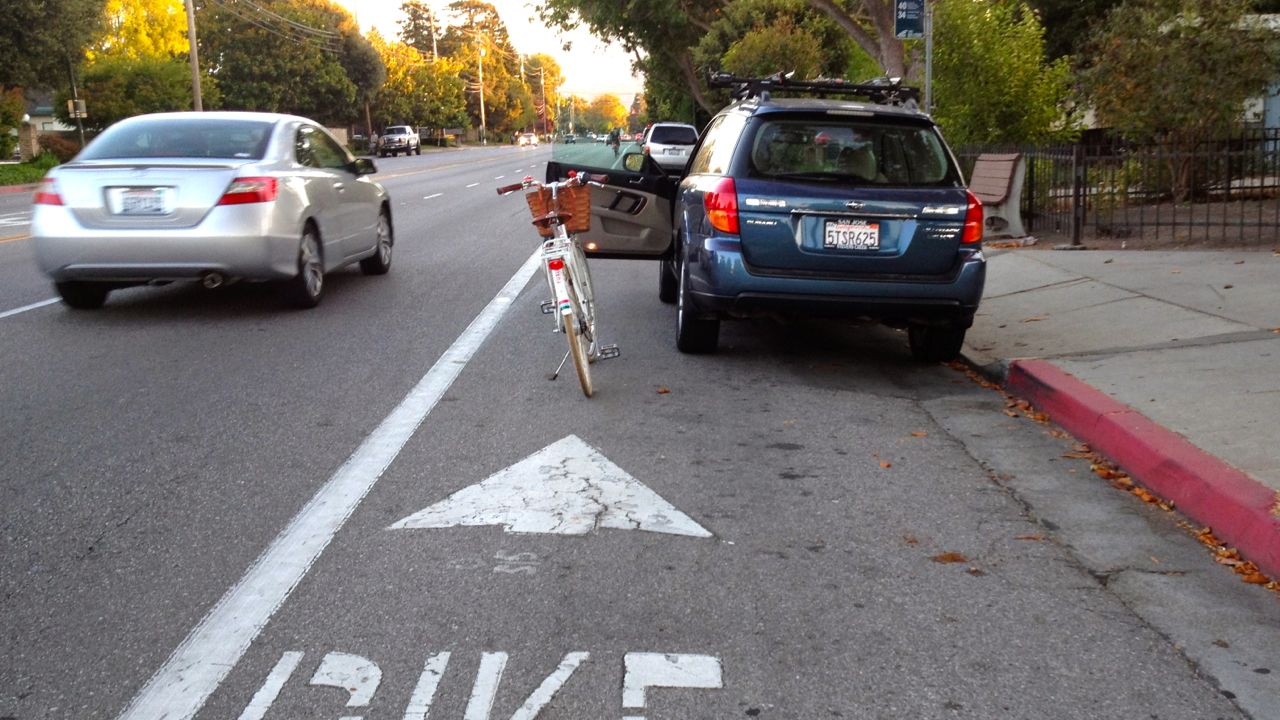
Many bike lanes in Mountain View, including those on California Street, are dangerously striped in the “door zone.” The road diet will allow wider bike lanes so doors aren’t a hazard, making for a low-stress riding experience. Source: Janet LaFluer
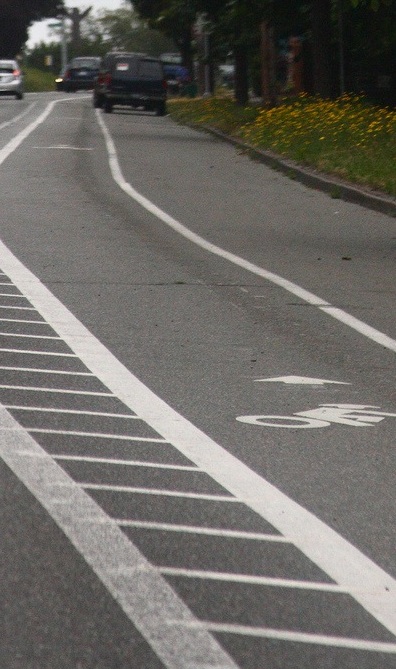
The road diet would allow for wider bike lanes with a painted buffer. Source: Will Vanlue
The extra space can also accomodate wider bike lanes that are safer and make cycling a more attractive transportation option. The existing bike lanes on California Street are within what’s called the door zone, which means if a person in a parked opens their door without looking, a cyclist may collide with the open door or be forced to swerve into the traffic lane. Both outcomes can lead to injury or death, and cyclist riding in a door zone lane must constantly fear for her safety since every parked car is a potential hazard.
For pedestrians, the additional space are perfect for “bulb outs,” which reduces the crossing distance between sidewalks at intersections, minimizing risk. Additionally, the curb corners can be tightened so vehicles can’t carelessly speed around corners, ignoring and potentially endangering those in the crosswalk.
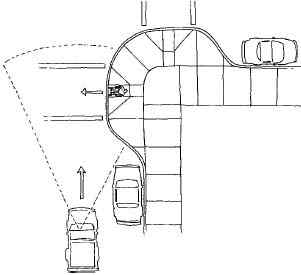
Bulb outs not only shorten the crossing distance for pedestrians, but increase visibility. Source: FHWA
Future Traffic Increase?
In reference to the California Street road diet, Public Works Director Mike Fuller is quoted in the Voice: “But with the projected future (traffic) volumes, we may not be able to.” The projections he’s referring to are in the city’s new General Plan, which is based on a conservative model that assumes minimal reduction in driving by 2030. However, increases in car traffic are not an inevitable force of nature. Building safer, more accessible streets that provide a range of transportation options are key to making the city more livable and improving the quality of life.
UPDATE 9/9/12: The original link to the FHWA study was incorrectly linked to an earlier 2004 study that concluded road diets had limited impact on safety. The FHWA did a follow-up study in 2010 with a more detailed statistical model and found that road diets do have a positive impact on safety. The link in the article has been changed to the 2010 study.
by jarkatmu | Aug 30, 2012 | Uncategorized
We are delighted that Mountain View Voice has an article about GSRP and the street modifications we would like made to improve the safety and public spaces for everyone in Mountain View.
If this is your first time here, Please sign up for our newsletter and read our vision.
